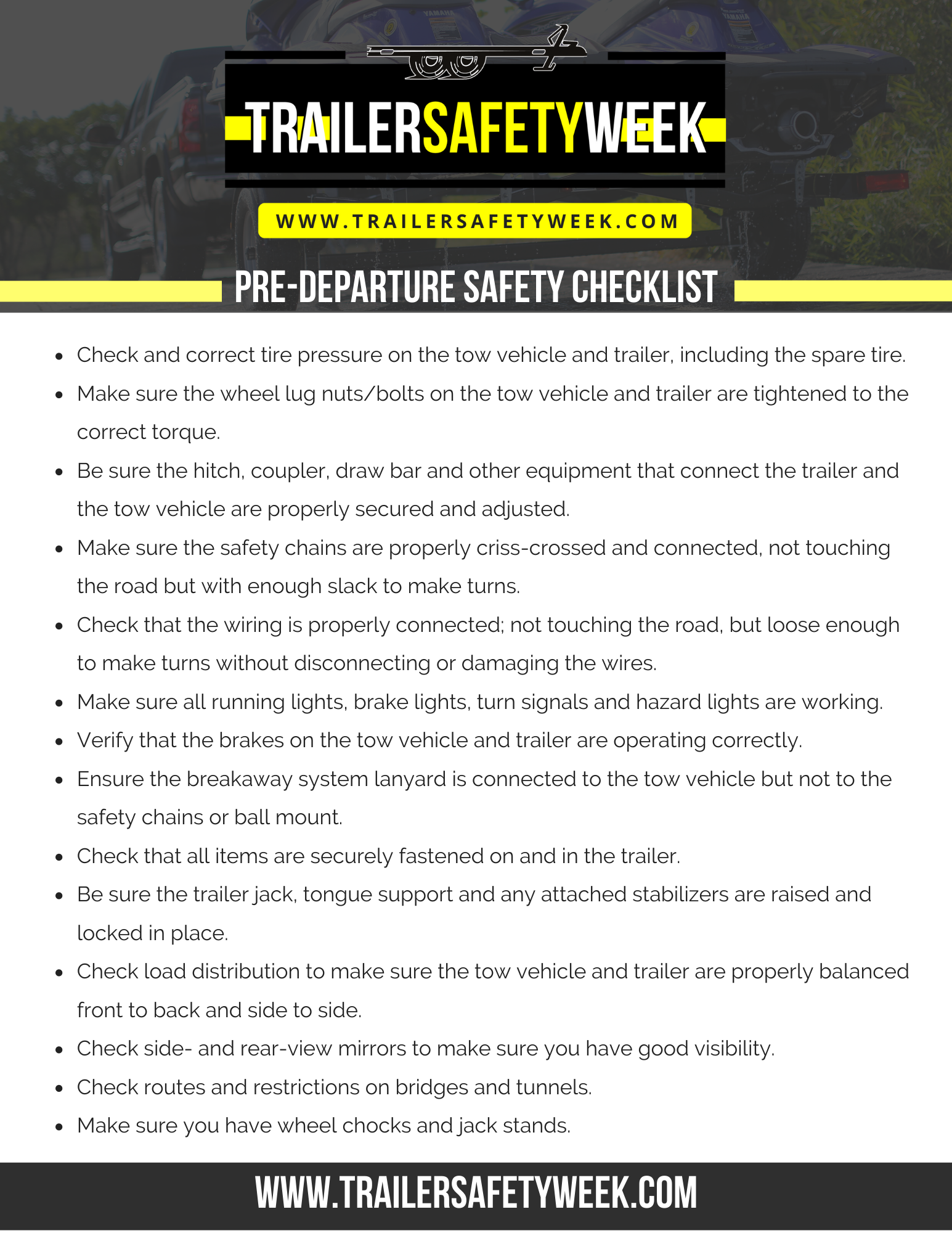Pre-Departure Checklist | Speed | Stopping | Turning | Hills | Backing Up | Crosswinds | Passing | Responding to Sway
Driving Tips
Towing involves the interaction of a number of components; the driver, tow vehicle, and trailer. Each of these contributes to the towing experience and safety of the combination. The driver is responsible for selecting the proper tow vehicle and trailer for the load, properly hitching the trailer, properly loading and securing cargo, and properly operating the tow vehicle including operating the combination at the appropriate speed, steering, and braking. The overall towing experience is greatly improved by choosing a tow vehicle with the appropriate brakes, tires, mirrors, hitches, etc. for the intended trailer. The trailer components should be appropriate for the trailers intended use including appropriate brakes, tires, axles, lighting and more.
Safe and proper driving habits are a crucial component of overall trailer safety. Drivers should always maintain focus while operating a motor vehicle and eliminate distractions.
Pre-Departure Checklist
Speed
Slow down and create longer following distances between you and the vehicle in front of you. Most states have a speed limit of 55 when towing. According to U-Haul, towing while maintaining speeds over 55 mph can consume 35% more gasoline. Slowing down is not only safer, it is more economical.
Stopping
On trailer models with brakes installed, the combination will require a greater stopping distance with a trailer in tow than the tow vehicle requires while operating by itself. Likewise, even smaller trailers that do not require brakes will require longer stopping distances for the combination than the tow vehicle requires while operating by itself. Even with adequate trailer brakes, if applicable, the tow vehicle will still have a greater stopping distance with a trailer attached. It takes experience for drivers to become comfortable with the difference between the way their vehicle handles by itself, versus the way the vehicle handles while towing a trailer loaded with cargo.
For following distances, a general rule of thumb is at least a 325 foot gap (about 5 seconds) between your vehicle and the vehicle or obstacle in front of you. Prolonged use of brakes can cause overheating and loss of brake effectiveness. Giving yourself ample space to respond should help prevent frequent and/or hard braking.
"Safe Trailering." This booklet was developed by U-Haul International, Inc., in cooperation with the American Driver and Traffic Safety Education Association (ADTSEA).
Turning
The turning radius of your vehicle will increase with a trailer attached. A gooseneck or fifth wheel attachment has a tighter turn radius than a traditional ball mount attachment.
When turning, swing the tow vehicle wider, giving yourself ample room for curbs, corners, or any other obstacles on the inside corner.
Hills
While traveling both uphill and downhill, slow down and shift into a lower gear. While traveling downhill, reducing your speed will help stabilize your vehicle and trailer combination.
"Safe Trailering." This booklet was developed by U-Haul International, Inc., in cooperation with the American Driver and Traffic Safety Education Association (ADTSEA).
Backing Up
Backing up can be the most difficult aspect of trailering. If possible, have another individual acting a spotter to aid with blind spots.
The trailer will move the opposite direction of the tow vehicle when backing up. The best method is to hold the bottom of the steering wheel. To turn left you move your hand to the left and to turn right you move your hand to the right.
Single axle trailers will cut more rapidly than tandem axle trailers. If you find you are turning too far, have jackknifed, or are otherwise situated incorrectly, pull forward and start again.
Once parked, make sure to have blocks ready for the trailer tires, avoid parking on slopes, and apply the parking brake. If the trailer is to be unhitched, unload the cargo first. Then make sure safety chains and the pin connector/electrical plug are disconnected.
An empty parking lot is a fantastic place to practice these maneuvers. Better to learn the movements of your trailer here than at the boat ramp, campsite, or in front of a busy store.
Crosswinds
Decreasing speed and steering straight will lessen the effects
Passing
Passing in a combination (tow vehicle and trailer) will take more time and more distance to pass. As with driving a car, do not pass on a hill or curve as you will need to ensure there is plenty of clear roadway ahead. Your larger vehicle combination has a larger impact on airflow and will cause both your vehicle and the vehicle being passed to sway or move more than usual, plan accordingly, ensuring enough roadway space for both vehicles.
Respond To Sway
Gas off, brake off, steer straight and wait.
DO NOT attempt to control sway by turning the steering wheel as it will only make the issue worse. If you have a brake controller, gently apply only the trailer brakes.


